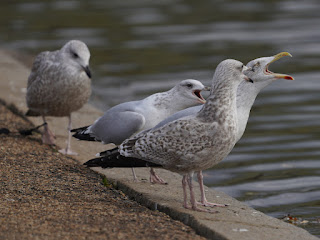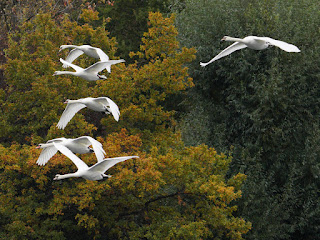A female Pied Wagtail hunted insects between the slates of the boathouse roof. Females have a grey back, males a black back.
Her mate was higher up on the roof.
A Carrion Crow posed on a dead tree near the Italian Garden.
A pair of crows enjoyed a bathe in the Serpentine.
We still don't have any winter migrant thrushes. This is odd, because a fair number of Blackbirds have arrived in St James's Park. Like many of the migrants this male eating rowan fruit is a first-year bird, as you can tell by his dark bill and eye ring. Thanks to Mark Williams for the picture.
The Peregrine was on the crane again. By the time I could get this shot the light was terrible so it's a poor picture, but it was taken from 150 yards away.
A Herring Gull family called together on the edge of the Serpentine.
A young gull played with a tennis ball.
Moorhens amused themselves by climbing on the iris leaves in the Italian Garden.
The Black Swan has returned from the Round Pond and was on the Long Water. The dominant male Mute Swan gave it a nasty look, and I think trouble is brewing. Probably the Black Swan went to the Round Pond after losing a fight on the Serpentine. This feisty creature does put itself in harm's way.
Swans gathered around something that interested them in the Serpentine. A Coot and a Black-Headed Gull came over to see if there was anything for them, but I think it was only a patch of algae.
Swans flew up the Serpentine, made a wide turn at the bridge, and went back the way they had come.
For some reason almost all the geese in the park -- Greylag, Canada and Egyptian -- have moved from the main lake to the Round Pond.
The female Wigeon was still at the east end of the Serpentine.
Honey Fungus has come up at the same time in many parts of the park.
It's possible that the whole lot are the same organism, with an underground mycelium extending all over the park. The largest living thing in the world is probably a patch of an American species of Honey Fungus in the Blue Mountains of eastern Oregon, covering 2200 acres (890 hectares).













I may never commented on this before, but I do enjoy watching the large flocks of geese so. It always marvels me how many there are!
ReplyDeletePerhaps the migrant Thrushes has been detained by the cold spells in northern Europe? I suppose your Thrushes must come from Scandinavia.
Cold spells in norther Europe should accelerate rather than retard migration. But the thrushes seem to have arrived everywhere except here. I think they should get through in a day or two.
DeleteInteresting about migrant thrushes as many thousands of Redwing have been recorded passing over London with smaller numbers of other species, but relatively few seem to have come down. Surrey also had some massive movements with Leith Hill breaking the county's records with over 34,000 in a day. Where did they all go?
ReplyDeleteLove seeing flocks of geese together. Not quite Norfolk but still good to see. Some lovely swan photos too.
Still no thrushes today. The rowan trees are full of bright red fruit visible from the air, but no takers.
Delete